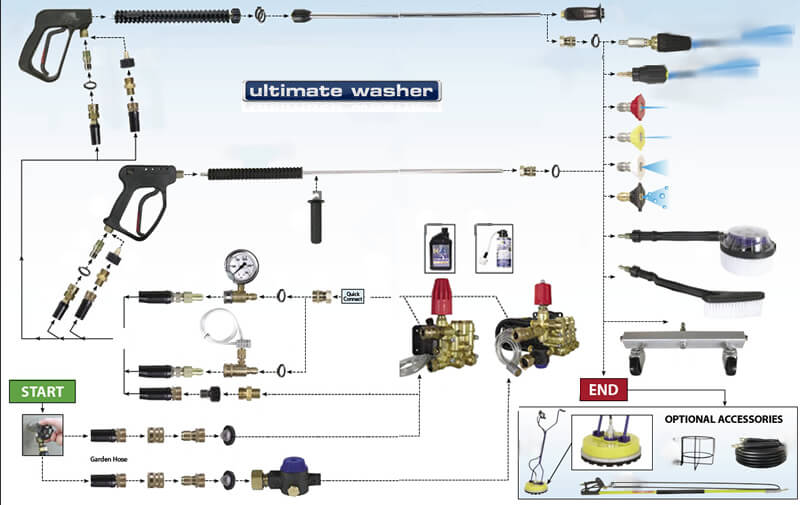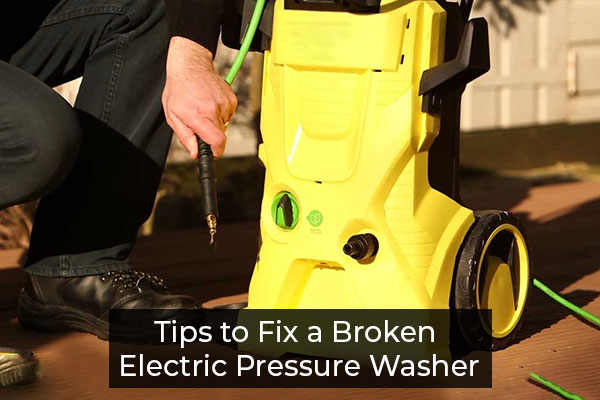The fuse on an electric pressure washer is typically located near the power cord or inside the unit. Consult the user manual for specific placement details.
Electric pressure washers are essential tools for various cleaning tasks. They provide powerful, efficient cleaning for driveways, vehicles, and patios. Understanding the components of your electric pressure washer, including the fuse, can enhance its performance and longevity. The fuse serves as a safety feature, protecting the unit from electrical overloads.
Knowing its location allows for quick troubleshooting if the machine fails to operate. Regular maintenance, including checking the fuse, ensures your pressure washer runs smoothly. With proper care, it can be a reliable ally for all your cleaning needs.
Page Contents
- 1 Introduction To Electric Pressure Washers
- 2 Safety First: Preparing To Locate The Fuse
- 3 Identifying The Fuse Type In Your Pressure Washer
- 4 Locating The Fuse: A Step-by-step Guide
- 5 Testing The Fuse: Is It Blown?
- 6 Replacing The Fuse: Ensuring The Right Fit
- 7 Troubleshooting: When A New Fuse Doesn’t Solve The Issue
- 8 Preventive Measures: Avoiding Future Fuse Problems
- 9 Conclusion: Restoring Your Electric Pressure Washer
- 10 Frequently Asked Questions
- 11 Conclusion
Introduction To Electric Pressure Washers
Electric pressure washers are powerful tools for cleaning. They use water and pressure to remove dirt. Understanding the essential components helps in proper use and maintenance.
The fuse is a vital part of the pressure washer. It protects the machine from power surges. If the washer stops working, check the fuse first. A blown fuse can cause problems.
| Common Issues | Possible Causes |
|---|---|
| Machine Won’t Start | Blown fuse, power cord issue |
| Low Pressure | Clogged nozzle, air in the pump |
| Leaks | Worn seals, loose connections |

Credit: m.youtube.com
Safety First: Preparing To Locate The Fuse
Safety is crucial before working on an electric pressure washer. Always disconnect the power to prevent accidents.
Find the main power switch and turn it off. Next, unplug the washer from the outlet. This ensures there is no electricity flowing.
Gather these necessary tools:
- Flathead screwdriver
- Phillips screwdriver
- Multimeter for testing
- Protective gloves
- Safety goggles
Having the right tools makes the process easier. Always wear protective gear for safety.
Identifying The Fuse Type In Your Pressure Washer
Electric pressure washers often use two types of fuses: cartridge fuses and blade fuses. Cartridge fuses are cylindrical and can be easily replaced. They fit snugly into a fuse holder. Check for a glass or ceramic casing to identify them.
Blade fuses are flat and have two metal prongs. They plug directly into a fuse box. These fuses are usually color-coded for easy identification. Each color represents a different amperage rating.
Knowing the type of fuse helps in finding the right replacement. Always ensure the power is off before checking or replacing any fuses. This keeps you safe while working with your electric pressure washer.

Credit: www.ultimatewasher.com
Locating The Fuse: A Step-by-step Guide
Finding the fuse on your electric pressure washer is essential for maintenance. Start by consulting the user manual. This document usually shows the exact fuse location. It may vary by brand and model.
Common locations for the fuse include:
| Location | Description |
|---|---|
| Near the Power Cord | Look where the power cord connects to the machine. |
| Inside the Control Panel | Open the control panel to check for the fuse. |
| Underneath the Machine | Check the bottom of the pressure washer. |
Always unplug the washer before inspecting the fuse. This ensures safety during the process. Replace a blown fuse with one that matches the specifications.
Testing The Fuse: Is It Blown?
To check the fuse, you need a multimeter. This tool measures electric current. First, ensure the pressure washer is unplugged. Set the multimeter to the ohm setting. Connect the leads to the fuse terminals. A reading of zero ohms means the fuse is good. A reading of infinity indicates the fuse is blown.
Look for visual signs that might indicate a blown fuse. Check for any burn marks on the fuse. A discolored or broken filament is also a sign. If the fuse looks damaged, it should be replaced immediately. Always use the same type of fuse for safety.
Replacing The Fuse: Ensuring The Right Fit
Replacing the fuse is important for your electric pressure washer. Choose the correct replacement to avoid future issues. Look for the manufacturer’s specifications. This ensures compatibility with your model. A wrong fuse can cause problems.
For installation, follow these simple tips:
- Always unplug the washer before starting.
- Use a screwdriver to open the fuse compartment.
- Carefully remove the old fuse.
- Insert the new fuse securely.
- Close the compartment and test the washer.
Troubleshooting: When A New Fuse Doesn’t Solve The Issue
Check the power cord for any damage. A broken cord can stop the washer from working.
Inspect the GFCI outlet. If it trips, reset it to restore power. Make sure the circuit breaker hasn’t blown, as that can cut off electricity too.
Look at the switch and trigger. Both should function properly for the washer to start. Check the pump for clogs or damage that may prevent it from operating.
Sometimes, the motor may fail. If you suspect this, it’s best to get help from a professional. They can diagnose and repair more complex issues.
Preventive Measures: Avoiding Future Fuse Problems
To avoid future fuse problems, regular maintenance is essential. Check the power cord for any damage. Inspect the nozzle for clogs or blockages. Clean the filter regularly to ensure proper water flow.
Safe operating practices can also help prevent issues. Always use the pressure washer on a flat surface. Ensure the ground is dry before using it. Keep children and pets away during operation.
Follow the manufacturer’s guidelines for best results. Store the pressure washer in a dry place. Disconnect the power when not in use. Regular checks will keep your equipment in good condition.
Conclusion: Restoring Your Electric Pressure Washer
To restore your electric pressure washer, follow these simple steps. First, locate the fuse in your device. It is usually near the power cord or the motor. Check for any signs of damage or burning. If the fuse is blown, replace it with a new one. Make sure the new fuse has the same rating as the old one.
Next, inspect the power cord for any cuts or frays. A damaged cord can cause issues. Ensure all connections are secure and tight. If problems persist, consult the manual for further troubleshooting tips. Regular maintenance keeps your pressure washer running smoothly.
Remember to store the device in a dry place. This helps prevent future issues and extends its life.

Credit: www.moglix.com
Frequently Asked Questions
Where Can I Find The Fuse On My Electric Pressure Washer?
The fuse on an electric pressure washer is typically located near the power cord connection or inside the control panel. Check the user manual for your specific model for precise location details. Always ensure the washer is unplugged before attempting to locate or replace the fuse.
How Do I Check The Fuse On My Pressure Washer?
To check the fuse, first, unplug the pressure washer for safety. Remove the fuse cover, usually found near the power connection. Inspect the fuse visually or use a multimeter to test it. If the fuse is blown, replace it with one of the same rating to avoid further damage.
What Causes The Fuse To Blow On A Pressure Washer?
Fuses can blow due to several reasons, such as electrical surges, a short circuit, or an overloaded motor. Using the pressure washer on an extension cord not rated for high power can also cause issues. Always follow the manufacturer’s guidelines to minimize the risk of blowing a fuse.
Can I Replace The Fuse Myself?
Yes, you can replace the fuse yourself if you follow safety precautions. Ensure the pressure washer is unplugged before beginning. Use the correct fuse type and rating as specified in your user manual. If unsure, consult a professional to avoid potential hazards.
Conclusion
Finding the fuse on your electric pressure washer is essential for troubleshooting issues. Knowing its location helps you address problems quickly. Regular maintenance and awareness of your washer’s components can enhance its lifespan. Always consult your user manual for specific guidance tailored to your model.
Stay informed and keep your pressure washer in top shape.

